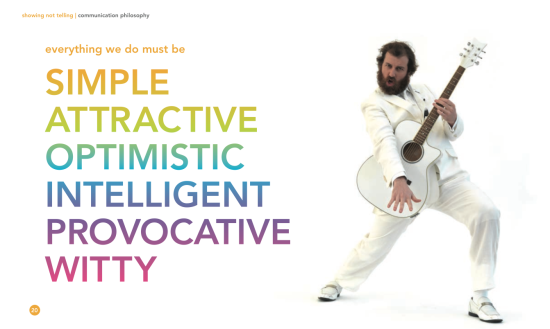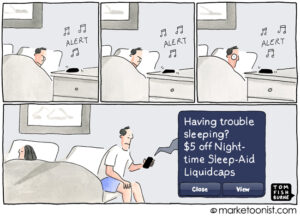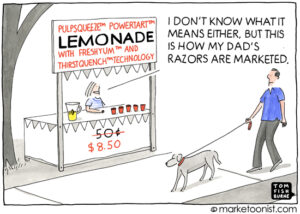How Draconian are your Brand Guidelines? Many brands focus so much on maintaining consistency that they forget one of the most important goals of Brand Guidelines — inspiring creative work.
Building a brand takes a village, inside the company and out. From agencies to packaging engineers, there are a lot of people who touch and influence how a brand comes to life. Marketers often put together guidelines to codify the rules of the brand.
When done well, Brand Guidelines are a rally cry that can inspire the extended team’s best work. When done poorly, Brand Guidelines are a wet blanket that ensures the status quo.
In 1997, I worked for one of the first interactive agencies in San Francisco, helping build web sites for Disney and others. I remember how difficult it was to apply the rigidity of the Disney Brand Guidelines to the relatively new medium of the Web. Because Disney wrote their guidelines from a print mindset, they unintentionally limited the potential of their agencies’ work and the resulting web sites looked and felt like virtual brochures.
I see the same dynamic at play today, with the evolving landscape of branding, from mobile to content marketing. Our extended brand teams need guidance, but they also need the freedom and flexibility to experiment.
When I worked at method, we invested a significant amount of effort in our Brand Guidelines for such a small company, updating Brand Guidelines practically every year. Our brand experience team tried to strike the right balance of consistency and inspiration.

Marketers should be more than Brand Police and Brand Guidelines should be more than a set of rules to enforce.
I’d love to hear your thoughts and stories about creating effective and inspirational Brand Guidelines.
(Marketoonist Monday: I’m giving away a signed print of this week’s cartoon. Just share an insightful comment to this week’s post by 5:00 PST on Monday. Thanks!)



Joy Panos Stauber says
This is so true. Good brand guidelines can almost act as an new employee orientation. They help people understand what the brand – and the people who will care about the brand – are all about so that the two points can connect.
Andrew says
The best brand guidelines and handbooks I’ve seen are the ones that spend a lot of time clearly defining what a brand is and what it’s personality should be. Those can be a great tool for inspiration and getting people into the right mindset. Instead, far too often they seem to become the penal code of what the brand isn’t and what it won’t do. If you do a good enough job at spelling out the former, the vast majority of the latter should take care of itself.
Mike says
As the keeper of our company’s Brand Identity Guidelines, I often feel like the logo police (right size, right colors, etc) so having a prison for offenders does not sound like a bad idea! Even though our Guidelines have a fairly extensive section defining our brand equity, personality/tone and what is/is not meant by the terms that define the personality, the users of our Guidelines focus more on the logo usage, trademark usage and guidelines for photography and recipe development.
Chgopeg says
Thank you once again for sparking a much-needed conversation.
Brand guidelines are more important than ever, now that one agency could be handling above the line work, another handling digital and/or social and yet another handling shopper—not to mention an overseas shop handling translations for international brands.
I couldn’t agree more with your assessment of Brand Guidelines done well vs. done poorly.
Being on the agency creative side, I’ve suffered the wrath of the latter more often than not. We’ve tried to convince clients that it’s called a Brand Guideline, not Brand Scripture. However, many of my clients have been scared into robotic thinking by their supervisors. In order to “not get in trouble” they define “consistency” as “exactly the same.” On one of my previous accounts, my clients’ bonuses were based on consistency (not profit)!! An example of why this is a terrible idea: I was asked to create a 728×90 web banner based on the art from the product packaging. On the packaging, the features icons were stacked vertically. However in my very short/wide format, I placed the same icons horizontally. I was told to stack them vertically so they were “consistent” with the packaging. I informed the client that the features would be so small they wouldn’t be legible to the consumer. I was told it didn’t matter if they were legible, they had to be exactly the same as the box. This client was more concerned with her bonus, than whether or not the consumer could read the features.
My point is not to make the above-unmentioned brand look bad. It’s to illustrate that brand guidelines, without the proper training of how to incorporate them, can hurt, not help the brand.
I look forward to people sharing their effective/inspirational Brand Guidelines.
Clare says
A brand with a powerful story, a point of view and clearly understands what constitute the brands visual iconology can be empowering to work with as it frees the brand custodians to be creative and build brand value. If a brand lacks these the time is spent trying to redefine the brand and makes it difficult for creative work to be judged as it becomes an opinion.
Pam says
I do see brand police putting a damper on creativity but, on the other hand it can serve as a safe guard to poor execution.
Receiving brand standards from an external source seems to lend its self to company-wide adoption. Recently re-branding was created internally and there seems to be less buy-in. Interesting reaction.
StephenM says
I think the best test for a set of Brand Guidelines is how much people within the company dislike them.
I work with a large corporate client with tightly controlled and minutely detailed brand guidelines, and a strict brand approval process.
As an outside vendor I am often stuck in the middle trying to satisfy my client and still create something brand compliant. I have sat in on some very contentious calls between my clients and the brand team. The discord often reaches the level of animosity seasoned with mutual disrespect.
If it reaches that level, they’re not doing it right.
Remedia says
Brand Police? More often the Brand Nazi.
Brand guidelines for the digital media should focus on creating the same experience either by the tone of the message, colour palette or even animation. I love it when brands allow their logo to be animated into some cool online. It allows the audience to really engage with the brand, rather than making it easy to ignore the logo by just stamping it on a web banner .
Viji says
Flexibility in the hands of a creative mind just out to do things differently may end up alienating loyalists without attracting new audiences.
The trick is in striking the right balance between consistency and creativity, both towards the common goal of keeping audiences engaged – a holy grail worth pursuing.
Laura says
As a former marketer now in Internal Comms, my main gripe is that guidelines are written by designers for designers with a VERY limited understanding of MS Office who live in an Adobe world.
Its all CMYK, exclusion zones and table/graph designs which cannot be automated in a template.
Also anyone who absolutely prohibits any internal project, team or campaign identities because “there is only one brand” does not understand human nature. Far better to allow some things like text identifiers (BP) than ban everything (GSK) as you will just encourage people to bypass brand entirely.
Laura says
And another thing
Readability and accessibility get very little attention.
10% of men have a colour visual impairment – yet many corporate colour palettes have bad combinations.